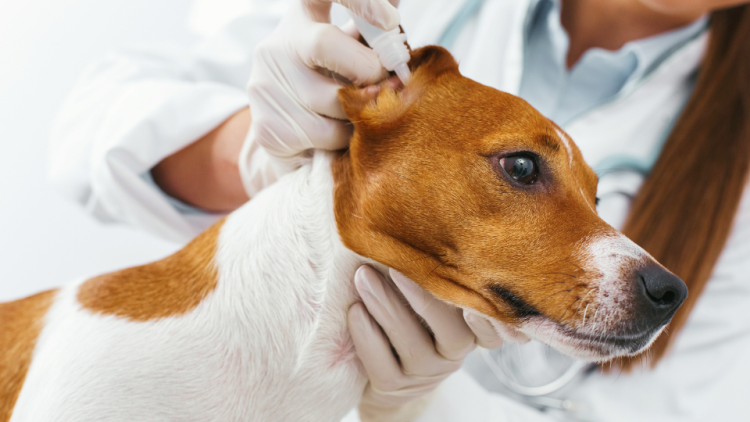If your companion is scratching or shaking their head more than usual, it might be because your dog has ear mites. Ear mites are very common parasites that cause severe itchiness and discomfort. Fortunately, although these parasites are highly contagious, treatment is relatively easy.
If you suspect your dog has ear mites, here is everything you need to know and the steps you need to take in order to get rid of them.
Table of Contents:
- What are ear mites in dogs?
- How do dogs get ear mites?
- What are the symptoms of ear mites in dogs?
- How to diagnose dogs with ear mites
- How to treat ear mites in dogs
- How to prevent ear mites in dogs
- Key Takeaways
Pro Tip: Treatment for mites, ear infections, and other common health concerns can be covered by a pet insurance policy that helps offset the financial burden that can come with providing your pet access to the best care possible.
What are ear mites?
Ear mites are some of the most common parasites that affect dogs. They usually live in the ear canal where they feed off of ear wax and skin oils, but can also be found on the skin surface. Ear mites are microscopic organisms that look like tiny white specks but can rarely be seen with the naked eye.
It takes about three weeks for an ear mite to develop into an adult, during which time it goes through five stages. An adult mite lives about two months but multiplies very quickly with eggs taking only four days to hatch. The entire life cycle of ear mites takes place on the host animal, even though they can survive for a short time in the environment.
In addition to canines, ear mites in cats, ferrets, hamsters, mice, and rabbits are also very common. If one pet in a household is diagnosed with ear mites, all pets should be treated at the same time, even if they aren’t showing clinical signs.
Humans are rarely affected as the ear mites that affect dogs are different from the parasite affecting humans. In very rare cases, dog owners have been known to develop skin rashes if their canine friend has ear mites.
How do dogs get ear mites?
The fact that mites can only survive for a limited time without a host makes them highly contagious.
Any dog can catch mites through direct contact with an infected animal, but puppies are more at risk because they haven’t built up a natural resistance to them yet.
Owners of older dogs should also be extra careful. If your senior pet has gotten a case of ear mites, there might be an underlying illness that’s compromising their immune system. Older dogs might also have more trouble dealing with the intense itching and pain caused by ear mite infection.
Pups who spend time outdoors in rural and wooded areas are also more susceptible, but ear mites can spread during social interactions with other pups or among those who live in animal shelters.

What are the symptoms of ear mites in dogs?
Besides fleas, ear mites are the second most common external parasite affecting pets after fleas. Common signs of ear mite infestation can vary in severity and might include the following:
- A crusty or waxy dark discharge from the ear resembling coffee grounds.
- A crusty rash in or around the ear.
- Ear irritation, resulting in a head shaking and scratching the ears.
- Patches of hair loss caused by scratching.
- A collection of blood within the ear’s cartilage and the skin (aural hematoma) resulting from rupture of small blood vessels due to scratching or shaking the ears.
Skin lesions usually affect the ears but in heavy mite infestations, they can also appear on other areas of the body.
Possible health complications in dogs with ear mites
Excessive scratching can result in infections and cuts in the ear. These open wounds can be attacked by bacteria and develop an infection.
Some pups might have a severe immune reaction to ear mites, which can cause unmanageable itching and intense irritation in the external ear. If your canine pal shows signs of hypersensitivity, be sure to get them to the vet as they might need immediate, aggressive treatment, usually in the form of injected medication to calm down the itching and soothe the skin.
If left untreated, ear mites can cause other complications, including damage to the ear canal and eardrum. In some dogs, this can result in complete and permanent hearing loss.
How to diagnose dogs with ear mites
Even though ear mites commonly cause ear irritation, other conditions, such as allergies or bacterial and yeast infections, can also result in similar clinical signs. That’s why you will need to get your canine companion to the vet in order to confirm the presence of mites. Without visiting a veterinarian, many pet parents assume that their pet has caught ear mites when they actually have an ear infection, which can result in inappropriate treatment and worsening of the condition.
Diagnosis of ear mites is usually quite straightforward. It is done either by examining the dog’s ears with an otoscope or by examining ear discharge under a magnifying glass or microscope.
In some cases, if your pup’s ears are very sore due to intense scratching, it can be quite difficult for them to stay still during the exam. In that case, your pet might need to be sedated in order to be properly diagnosed and treated.

How to treat ear mites in dogs
Your vet will determine the most appropriate treatment for your pet’s specific case.
Once an ear mite infection is confirmed, your veterinarian will clean your pet's ears in order to remove as many mites as possible and then apply an antiparasitic medication to your dog's ears. If the dog's ear mite infestation is advanced, the veterinarian may also prescribe antibiotics.
When it comes to ear mite treatment for dogs, vets can choose from topical medications which are applied daily, injections like ivermectin, or single-use products like Milbemite, Bravecto, and Simparica. Most spot-on flea treatments also treat and prevent ear mites. These treatments are the easiest and most efficient way to protect your dog from parasites.
Dog ear mites can also be treated with ear drops, which usually need to be administered for about three weeks as the medication can’t penetrate the mites in a larval stage, so treatment is directed at killing the adult mites which take three weeks to develop. Other topical treatment options are much stronger and need to be used for up to two weeks.
After initial treatment, your vet will probably recommend a follow-up visit, to make sure that the ear mite infestation is completely eliminated. They might also advise you to administer frequent ear cleaning for up to a month in order to remove any mites that may still be hanging on.
Pro Tip: Ear infections are also very common and often share the same symptoms as ear mites in dogs. Pet insurance can help you cover the cost of treating and managing your pet’s ear infection.
How to prevent ear mites in dogs
In addition to treating every pet in your household, you’ll also need to mite-proof your home. Getting rid of grown mites and their microscopic eggs is the best way to reduce or eliminate the risk of re-occurrence.
Be sure to clean all soft surfaces that the infected pet might have been in contact with. These might include the pet’s bed but also your own bed, sofas, curtains, chairs, and soft toys. Wash everything in hot water and thoroughly vacuum anything that can’t be washed.
It is also a good idea to regularly clean your pup’s ears, whether at home or at the groomer’s. Finally, don’t forget to ask your vet about prescription tick and flea medications that double as mite preventatives.
Key Takeaways
- Ear mites are a common parasite in pups, but they can also affect other animals like cats and rabbits. Luckily, these parasites are rare in humans.
- Ear mites can barely be seen by the naked eye and a diagnosis needs to be made by a veterinarian. Not all ear infections in dogs are caused by mites, which is why a veterinarian will need to examine the affected animal.
- A range of treatments for ear mites in dogs are available but flea prevention often also protects dogs from ear mites. Check with your veterinarian for the best treatment and prevention strategy.
- Pet insurance can help you cover the expenses of veterinary care for ear issues.
